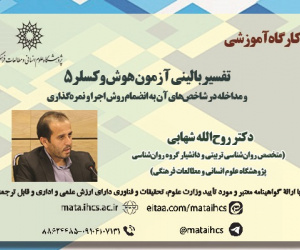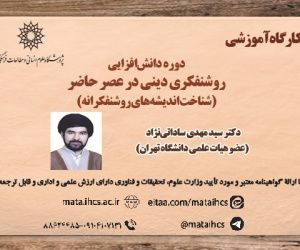مؤلفه های تدریس اثربخش تاریخ هنر بر اساس سند تحول و اهداف آموزشی بلوم(مطالعه موردی تاریخ هنر هنرستان) (مقاله علمی وزارت علوم)
درجه علمی: نشریه علمی (وزارت علوم)
آرشیو
چکیده
با توجه به فراز و فرودهای شیوه سنتی آموزش تاریخ هنر در هنرستان و لزوم توجه به سیاستهای کلان فرهنگی همچون سند تحول بنیادین آموزش و پرورش، مقاله پیش رو با هدف ارتقا سطح آموزش تاریخ هنر بر مبنای سطوح یادگیری بنیامین بلوم، محتوای کتاب تاریخ هنر هنرستان را به شیوهی توصیفی تحلیلیموردارزیابیقراردادهاست. چراکه هماره توجه به الگوهایآموزشیخلاقبارویکردیاددهی_یادگیری در تمام ساحتهای هنر میتواند موجبات رشد بصیرت در زمینه های فرهنگی و افتخار به ارزشهای اصیل و ماندگار ایران اسلامی را فراهم سازد. نتایج تحقیق حاکی ازاین است که به رغمکاربست تصاویر، پرسشهای پایانی وجداول، اهداف شناختی در آموزش هنر مورد توجه قرار نگرفته و کتاب مذکور نتوانسته با نهادینه کردن آموزش و تسلط بر یادگیری، درانتقال مضامین تاریخ هنر و غنا بخشی به هویت ایرانی اسلامی موفق عملکند. بنابراین در پژوهش پیش رو سعی شده با توجه به تجربه تدریس نگارنده، استناد به نظریه یادگیری بنیامین بلوم، سندتحول (ملی)آموزش وپرورش و منابع کتابخانه ای، شیوههای نوین آموزش تاریخ هنر تشریح وتبیین گردد. راهکارهای اصلاحی و تکمیلی همچون تدوین نظام تصویری منسجم، واژه نامه تخصصی، محتوای الکترونیک در قالب بارکد (رمزینه) به منظور غنی سازی و تنوع بخشی محیط های یادگیری در فرایند آموزش تاریخ هنر از جمله پیشنهادات کاربردی میباشد.Identifying the components of effective art history teaching based on the development document and Bloom's educational goals (conservatory art history case study)
The art history of any society explains science, knowledge and social customs in specific times and places and is based on the ideas that emerge from the clash of cultural influences. In other words, familiarity with the past civilization, the course and review of the works of art transforms the artist into a literary searcher and creator of beauty. In the age of technology, the meaning of art and its form have also changed to express visual communication, while the above concepts are not seen in the art history book of the Academy. The way of presenting art history knowledge should be based on creating a balance between society's expectations and expectations, understanding and individual abilities. Things like understanding cultural concepts, applying the necessary innovations in the creation of cultural and artistic works, trying to preserve and analyze the heritage of civilization, which are among the theoretical foundations of the approaches and operational goals of the education and training transformation document. The rich history of the past has taken on the color of decay and instability due to the lack of codified and coherent programs or the lack of proper implementation, because the transformation and promotion of scientific and artistic human capital to achieve sublime values and innovations, to promote the spirit of independence and self-sufficiency, to realize values and Transcendent ideals, the revival of Iranian Islamic identity and civilization, as well as the progress of society, depend on the field of education. Since the author as an art student of the conservatory textbooks still sees the mentioned problem and challenge still in force, no one has yet examined the challenges and obstacles from the mentioned point of view. Bloom achieved the institutionalization and application of knowledge and took a step to produce works of art with native identity as well as the stability of Iranian Islamic culture and filled this gap as much as possible. With the aim of improving the level of art history education based on Benjamin Bloom's learning levels, the following article has evaluated the content of the art history book of the conservatory in a descriptive and analytical way. Also, referring to Benjamin Bloom's learning theory, the (national) education and upbringing document and library resources, the new methods of teaching art history should be described and explained. Considering the traditional way of teaching art history in the school of art and the need to pay attention to macro-cultural policies such as the document on the fundamental transformation of education,the upcoming essay aims to improve the level of art history education based on the learning levels of Benjamin Bloom,the content of the book History of Art has evaluated the academy in a descriptive and analytical way. Because always paying attention to creative educational models with a teaching-learning approach in all fields of art can lead to the development of insight in cultural fields and pride in the original and enduring values of Islamic Iran. The results of the research indicate that despite the use of images,final questions and tables,cognitive goals have not been taken into account in art education and the mentioned book has not succeeded in conveying the themes of art history and enriching Iranian Islamic identity by institutionalizing education and mastering learning. Therefore in the upcoming research,considering the author's teaching experience,referring to Benjamin Bloom's learning theory,the(national)education and upbringing document and library resources,the new methods of teaching art history have been described and explained. Corrective and supplementary solutions such as compiling a coherent visual system,specialized glossary,electronic content in the form of a barcode(code)in order to enrich and diversify learning environments in the process of teaching art history are practical suggestions. According to the sources that the researcher has access to, there are no books, dissertations or translations related to the details and concerns of the topic, and the issue still remains. However, in some of the articles, whether translated or authored, some variables present in the title of the article have been discussed in the form of general topics or theoretical frameworks. Although the study and attention to learning theories such as Benjamin Bloom's in the teaching of various subjects have been repeatedly researched in psychology articles and books in the field of education and training, but few researchers have criticized the art history book of the art history. Corrective and supplementary solutions such as compiling a coherent visual system of the motif and the role of the subjects mentioned in the book in order to familiarize the student with the idea of visual principles, attaching a specialized glossary to the book, providing electronic content in the form of a barcode (code) in order to enrich and diversify The part of learning environments in the process of teaching art history is one of the practical suggestions







